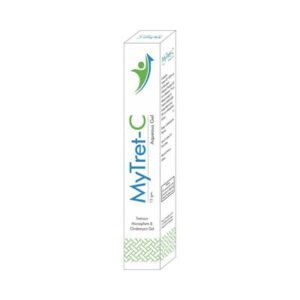TRETINOIN + CLINDAMYCIN
Tretinoin: Tretinoin is a medication used primarily to treat acne and reduce the appearance of wrinkles and other signs of aging on the skin. It is a derivative of vitamin A and belongs to the class of medications called retinoids.
The mechanism of action of tretinoin involves its ability to bind to specific nuclear receptors in the skin cells. This binding activates a series of gene expressions that regulate cell growth and differentiation. By promoting the turnover of skin cells, tretinoin helps to unclog pores, reduce the formation of acne lesions, and improve the overall texture and appearance of the skin.
Tretinoin is available as a topical cream, gel, or solution and should be applied to the affected areas once daily in the evening. It is important to clean and dry the skin before applying the medication, ensuring that it is not applied to open wounds or sunburned skin. It may take several weeks of treatment before the full benefits are observed.
As with any medication, there are some potential side effects associated with tretinoin. Common side effects include redness, dryness, peeling, itching, and burning sensation at the application site. These side effects often occur during the first few weeks of treatment and may gradually improve with continued use. In some cases, tretinoin may cause temporary hyperpigmentation or increased sensitivity to sunlight, so it is important to apply sunscreen and avoid excessive sun exposure.
In rare cases, tretinoin may cause more severe side effects such as severe skin irritation, blistering, or swelling. If any of these occur, it is important to discontinue use and seek medical attention.
Tretinoin should not be used by pregnant women as it may cause harm to the fetus. It is also not recommended for individuals with a known allergy to tretinoin or any of its components.
Overall, tretinoin is an effective medication for treating acne and improving the appearance of the skin. However, it is important to use it as directed and be aware of its potential side effects. It is best to consult with a healthcare professional or dermatologist before starting tretinoin treatment.
Clindamycin: Clindamycin is an antibiotic medication that is commonly used to treat various bacterial infections. It belongs to the lincosamide class of antibiotics and is available in both oral and injectable forms.
Clindamycin works by inhibiting bacterial protein synthesis, preventing the bacteria from growing and multiplying. It is effective against a wide range of bacteria, including Staphylococcus, Streptococcus, and anaerobic bacteria such as Clostridium and Bacteroides.
The dose of clindamycin can vary depending on the type and severity of the infection being treated. For oral administration, typical doses range from 150 to 450 mg every 6 hours, while intravenous doses may be higher.
As with any medication, clindamycin may cause side effects. Common side effects include gastrointestinal disturbances such as diarrhea, nausea, and vomiting. More severe side effects are rare but can include severe allergic reactions, rash, and inflammation of the colon (pseudomembranous colitis). It is important to inform the healthcare provider immediately if any unusual or severe side effects occur.
Clindamycin may interact with other medications, so it is essential to let the healthcare provider know about all other medications or supplements being taken. It is also important to complete the full course of treatment prescribed by the healthcare provider, even if symptoms improve, to ensure complete eradication of the infection and to prevent antibiotic resistance.

